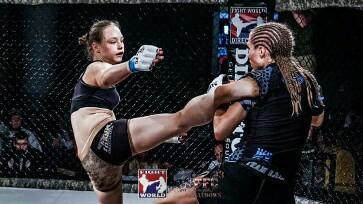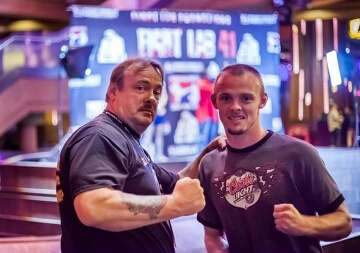Western North Carolinians looking to stay fit and blow off steam might turn to yoga or try outdoor activities like running, hiking or biking. But these days, growing numbers of area residents are taking their quest to a different level that includes armbars, takedowns and sometimes getting punched in the face.
First emerging in the U.S. during the 1980s, mixed martial arts started really gaining traction in the ’90s and has since taken the country by storm, becoming a multimillion-dollar business and inspiring a new generation of fighters to try their hand in the octagon.
Combining a variety of fighting styles, from jiujitsu to wrestling to kickboxing, MMA measures overall fighting ability and technique, eliminating the boundaries between traditional combat sports.
Professionals have seen the sport’s audience expand from an underground cult following to an international fan base. “Tough man” competitions have evolved into full-fledged pay-per-view events; big money sponsors like Budweiser and Reebok have taken an active interest; and companies like the UFC and Bellator MMA have become major players in the sports world, spending millions in an effort to lure the sport’s top talent into their ranks and staging multifight events across the U.S. and around the world.
Meanwhile, here in WNC, several former professional fighters have opened their doors to folks wanting to expand their skills, improve their overall well-being and instill greater self-confidence.
And as the sport continues to grow, these trainers and students are finding their place amid the blood, sweat and broken dreams of the national MMA scene.

“I’ve made every mistake a pro fighter can make,” proclaims Johnny Buck, who co-founded Rogue Combat Club on Biltmore Avenue. But rather than harboring regrets, Buck has transmuted his experience into valuable lessons for students.
“I had nearly 30 fights and have been involved in all aspects of MMA: fighting, promoting, managing fighters, commentating and coaching,” says Buck, who fought under the moniker Buck Nasty before making the jump to trainer last year. “That experience has given me a lot of insight that other trainers don’t have.”
Last year, he and former women’s kickboxing champion Amanda Ballew rented the basement of Biltmore Fitness and began installing mats, equipment and an octagon, the eight-sided ring where fighters meet to do battle. Five to six days a week, the two teachers lead classes ranging from technique and fitness drills to sparring, seeing anywhere from five to 20 students per day.
“It’s really a mix,” says Buck, as students go through a grueling warmup regimen. “We have vegans, firefighters, people with no experience, others who are training to go pro.”
It’s a far cry from MMA’s origins, he notes. “The days of barroom brawlers are done. These men and women are supposed to be — and, in most cases, are — highly trained athletes.”
Mass appeal
But MMA’s recent rise in popularity, continues Buck, is a double-edged sword. “I’ve seen amateurs with 0-7 records, and promoters are still putting them on the cards to fill spots. Now, everyone with a Tapout shirt is an MMA fighter.” His criticism extends to the UFC — the sport’s premier promotional company — which he says is “pumping out poor-quality fights in mass numbers for a profit.”
Still, Buck sees Asheville as a prime place to stage fights, with one big caveat. “The biggest thing holding MMA back in WNC is the lack of legitimate promotion,” he maintains. “No matter how awesome your show is, if no one knows about it, no one comes.”
The best MMA shows, notes Buck, combine theatrics with physicality. “You have your good guys and bad guys: You sell just as many tickets to support everyone’s favorite fighter as you would to watch the heel take a beating.”
Taking a page from professional wrestling, fighters enter the arena to their own theme music, often a popular, high-energy song. As in professional boxing, there are often ring announcers, scantily clad “ring girls” to signal the beginning of each round, color commentators and raffles or entertainment between fights.
Fights are generally three to five rounds, though few go the distance. Fighters notch a win by landing a knockout, inducing an opponent to “tap out” (concede by means of a submission hold), or by decision, based on the scores the three judges award for each round.
Rogue Combat, says Buck, aims to offer something for every student, “whether you want to be a big-name fighter, just love training or want to get in shape doing something fun.” Those pursuing the sport solely as a fitness regimen can opt out of sparring. “MMA,” he explains, “isn’t just two people brawling in the cage every night: It can also allow the everyday athlete to get a great workout without the physical sparring and getting hit.”

Brie Andrews, who’s trained with Buck since 2012, says MMA has enhanced her self-confidence and physical well-being. “When I started with him, I was over 200 pounds,” she reveals. Andrews has since lost 60 pounds and become a fixture at Rogue.
“It’s great cardio, and mentally, I feel like it helps you be more astute and aware of your surroundings,” she explains.
Andrews believes women’s role in the sport “still has a long way to go, but I think girls are definitely becoming more of a topic. Whereas before, you’d get laughed out of the room for saying you’re a female who did this.”
And though she hopes to eventually test her mettle in the octagon, “Right now, I’m just trying to get everything dialed in. There’s so many aspects of training: If you’re off on one point, you probably won’t do too well.”
In the meantime, the rewards of her progress under Buck’s tutelage are more personal than professional. “I find it therapuetic,” she says simply.
From the beginning
Just outside Marshall, master Tony Rogers, a legend in the world of martial arts, is helping young fighters hone their skills. “I fought before people even knew what MMA was,” he says. “Back then we called it ‘shootfighting,’ which was full contact, anything goes.”
After an injury ended his professional career, Rogers moved to Florida and began training up-and-coming fighters. But he soon grew disenchanted with the politics he encountered in big gyms. “I wanted to get back to the roots of teaching martial arts and working with individuals without all the political stuff getting in the way,” he explains.
So, for the past eight years, Rogers has run Full Circle Martial Arts on a hillside overlooking Highway 25/70. It’s a small gym with a couple of coaches — just the way he wants it. Bigger gyms typically train upward of 30 students at a time, but Rogers believes his approach allows for more hands-on instruction. “Most gyms operate on a money situation,” he says. “They just chuck [fighters] in there, and these kids get the hell beat out of them.”
For his part, says Rogers, “I judge myself on my students: You throw a good combination, I’m right there; you throw a good kick, I’m right there; you put your hand down, I’m right there telling you to pick it up.”
And while he says he’s “too old to have an ego,” Rogers’ résumé speaks for itself. Awards, letters and autographed photos cover a wall in his home; his students and colleagues have run the gamut from kickboxing champion Jerry Clarke to legendary trainer Freddy Roach, from Chuck Norris to grand master John Pellegrini. “A lot of those people … have ranked me,” Rogers notes humbly.

At Full Circle, he offers training in both MMA and hapkido, a Korean martial art. Rogers’ students include men, women and children of all ages, including his own kids. “Both of my sons are good,” he exclaims proudly, adding, “Alex, my girl, she’s 8-2 [in fights].”
Rogers’ fighters have won belts and contests across the region. “Todd Ray, Bruce Gunter, Ryan Houston, Ben Perry — we’ve been very successful,” says Rogers, adding that while Full Circle receives no shortage of offers for fights around the Southeast, most aren’t local. “It would be really nice to have some more shows here in Asheville.”
Still, Rogers sees MMA’s growing popularity as a step in the right direction, particularly in regard to females’ role in the sport.
“I’ve waited a long time for women to finally get into it,” he says, praising UFC women’s bantamweight champion Ronda Rousey for bringing women out of the “back channels” of the MMA world. “We’ve always had women fighters — extremely talented. You just don’t see them.” He hopes Rousey’s success will change that.
Rogers credits MMA’s recent success to the excitement it offers. “People love blood sports, let’s face it. They loved boxing when Mike Tyson was in his prime. It’s always been that way.”
And as the number of fans and sponsorship opportunities continues to grow, Rogers hopes fighters will reap more of the rewards. Before going pro, he notes, “Many fighters have to pay a lot upfront. It gets kind of expensive.” But as the sport becomes more economically viable, he predicts, “You’ll start seeing fighters being able to earn a little more, which will help them through the training and learning process.”
Where’s the money?
Bruce Gunter, who holds an 8-2 record and two amateur championship belts, agrees. “I think they should pay fighters more money,” he says. “You’re only fighting maybe four times a year — if you can stay healthy during training.”
Inspired by friends who were already involved in the sport and by his wrestling experience in high school and college, Gunter says MMA “seemed like the natural next step.”

Echoing Buck, Gunter cites the lack of local options for fighters as one of the main barriers to MMA’s expansion in the region, especially for those living in remoter areas. “Where are they gonna go?” he asks. “The closest place is still a 45-minute drive.”
Nonetheless, Gunter hopes MMA’s rising popularity will create more opportunities for fighters around the mountains. Although his own career has now taken a back seat to his family, he hopes to remain involved in the sport and eventually open his own gym.
And even if he doesn’t see himself going pro anytime soon, Gunter cherishes the memories from his fighting career. “It takes a lot of time and dedication and effort, but it’s worth it,” he says. “I’ve done stuff that I’ll never regret, that I can tell my kids when I’m older. I look forward to the future.”






Just a quick note on this article:
Unfortunately, due to space and time limitations, I was only able to speak with a few of the many great fighters and gyms in the area. There are undoubtedly many more in WNC that deserve the attention and are doing awesome things regionally in the MMA world. Please feel free to post any gyms, trainers or fighters that weren’t touched on who you think deserve to be recognized here in the comment section. I’ll do my best to keep the list in the article updated as well. Thanks for understanding, and make sure to support local fight promotions around Asheville and the mountains!
Hi Max. Thank you for bringing attention to MMA in the WNC. Triple G is a not for profit MMA community center who trains and has trained world ranked UFC fighters, USA World Grappling Team Members, Ranked National Sumo wrestlers, College Wrestlers and Boxers. Our aim is to give back and benefit the community by providing affordable and accessible world class training and coaching in the disciplines that make up MMA. We want to build champions in life and competition. Please check out our website at http://www.triplegasheville.com. Email me at triplegasheville@gmail.com and I will respond with my contact info. Thanks!
J’AI UNE ECOLE DE KARATE ET DE KICK ,FULL ..ET JE CHERCHE A FAIRE DES CONTACTES AVEC D’AUTRES ECOLES ..EST CE QUE Y’A DES pOSSIBILITE DE FAIRE DES ECHANGES..
Cross Training Academy, Brazilian jiu jitsu in Flat Rock, since 1998. http://www.ctabjj.com/index.html